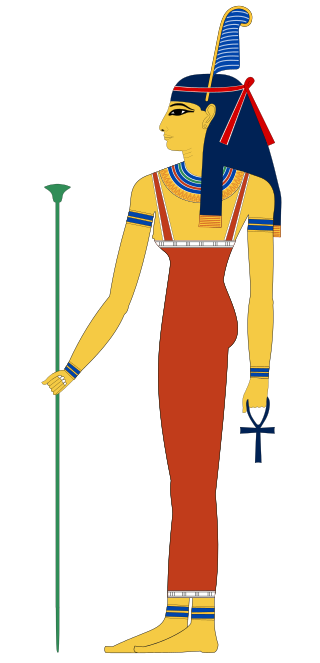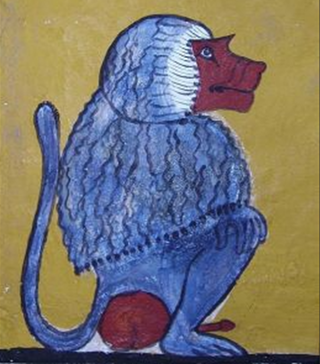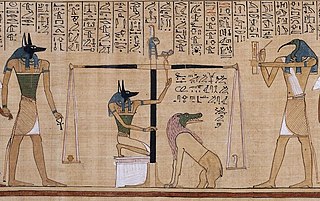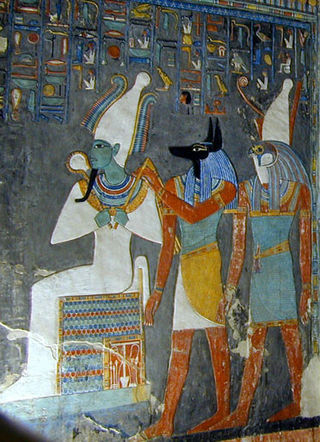
The Assessors of Maat were 42 minor ancient Egyptian deities of the Maat charged with judging the souls of the dead in the afterlife by joining the judgment of Osiris in the Weighing of the Heart. [1] [2]

The Assessors of Maat were 42 minor ancient Egyptian deities of the Maat charged with judging the souls of the dead in the afterlife by joining the judgment of Osiris in the Weighing of the Heart. [1] [2]
| Part of a series on |
| Ancient Egyptian religion |
|---|
 |
Chapter 125 [3] of the Book of the Dead lists names and provenances (either geographical or atmospheric) of the Assessors of Maat. A declaration of innocence corresponds to each deity: it is pronounced by the dead himself, to avoid being damned for specific "sins" that each of the 42 Judges is in charge of punishing. [1] [2]
The deceased was accompanied in the presence of Osiris by the psychopomp god Anubis – where he would have declared that he was guilty of none of the "42 sins" against justice and truth by reciting a text known as "Negative confessions". [4] The heart (ib / jb) of the deceased was then weighed on a two-plate scale: a plate for the heart, the other for the feather of Maat. Maat, in whose name the 42 judges who flanked Osiris acted, was the deification of truth, justice, rectitude, and order of the cosmos and was often symbolized by an ostrich feather (the hieroglyphic sign of her name). [5] [6] If the heart and the feather were equal, then the deities were convinced of the rectitude of the deceased, who could therefore access eternal life becoming mꜣꜥ-ḫrw (Egyptological pronunciation: Maa Kheru), which means "vindicated / justified", literally "true of voice" ("blessed" in a broad sense). [7] But, if the heart was heavier than Maat's feather, then a terrifying monster named ꜥmmt "the Devourer" ("Ammit") devoured it by destroying the soul of the deceased. [8] [9]
The psychostasia episode is remarkable not only for its symbolic and even dramatic vivacity, but also because it is one of the few parts of the Book of the Dead with moral connotations. The judgment by Osiris and by the other 42 judicial deities, [10] and the "Negative Confessions" themselves, depict the ethics and morality of the Egyptians. These 42 declarations of innocence were interpreted by some as possible historical precedents of the Ten Commandments: [11] but, while the Ten Commandments of Judeo-Christian ethics consist of norms attributed to a divine revelation, the "Negative confessions" seem rather as divine transpositions (each corresponding to one of the 42 judging deities) of daily morality. [12]
The American egyptologist Richard Herbert Wilkinson thus inventoried, in his The Complete Gods and Goddesses of Ancient Egypt (2003), the 42 Assessors of Maat: [2]
| Name of the deity | Identified with | Sin | Name of the deity | Identified with | Sin | ||
|---|---|---|---|---|---|---|---|
| 1 | "Far-Strider" | Heliopolis | falsehood | 22 | "Demolisher" | Xois | transgressing |
| 2 | "Fire-Embracer" | Kheraha | robbery | 23 | "Disturber" | Weryt | being hot-tempered |
| 3 | "Nosey One" | Hermopolis | stealing | 24 | "Youth" | Heliopolitan nome | unhearing of truth |
| 4 | "Swallower of Shades" | "the cavern" | murder | 25 | "Foreteller" | Wenes | making disturbance |
| 5 | "Dangerous One" | Rosetau (Giza Plateau [14] ) | stealing grain | 26 | "You of the Altar" | "the secret place" | violence |
| 6 | "Double Lion" | "the sky" | prolonging offerings | 27 | "Face Behind Him" | "cavern of wrong" | copulating with a boy |
| 7 | "Fiery Eyes" | Letopolis | stealing Gods property | 28 | "Hot-Foot" | "the dusk" | transgression |
| 8 | "Flame" | "came forth backwards" | lying | 29 | "You of the Darkness" | "the darkness" | quarrelling |
| 9 | "Bone Breaker" | Heracleopolis | taking food | 30 | "Bringer of Your Offerings" | Sais | unduly active |
| 10 | "Green of Flame" | Memphis | cursing | 31 | "Owner of Faces" | Nedjefet (13th / 14th Upper Egyptian nome) | impatience |
| 11 | "You of the Cavern" | "the West" | adultery | 32 | "Accuser" | Wetjenet | damaging a god's image |
| 12 | "White of Teeth" | Faiyum | causing tears | 33 | "Owner of Horns" | Asyut | volubility of speech |
| 13 | "Blood-Eater" | "the shambles" | killing a sacred bull | 34 | Nefertem | Memphis | wrongdoing |
| 14 | "Eater of Entrails" | "House of Thirty" | stealing land | 35 | Temsep | Busiris | conjuration against the king |
| 15 | "Lord of Truth" | Maaty | eavesdropping | 36 | "You Who Acted Willfully" | Tjebu | stopping water flow |
| 16 | "Wanderer" | Bubastis | complaints | 37 | "Water-Smiter" | "the abyss" | being loud voiced |
| 17 | "Pale One" | Heliopolis | being angry | 38 | "Commander of Mankind" | "your house" | reviling God |
| 18 | "Doubly Evil" | Andjet | adultery | 39 | "Bestower of Good" | the Harpoon Nome (7th / 8th Lower | doing ... ? |
| 19 | "Wememty-Snake" | "place of execution" | adultery | 40 | "Bestower of Powers" | "the city" | making distinctions for self |
| 20 | "See Whom You Bring" | "House of Min" | polluting body | 41 | "Serpent With Raised Head" | "the cavern" | dishonest wealth |
| 21 | "Over the Old One" | Imau | terrorizing | 42 | "Serpent Who Brings and Gives" | "the silent land" | blasphemy |

Anubis, also known as Inpu, Inpw, Jnpw, or Anpu in Ancient Egyptian is the god of funerary rites, protector of graves, and guide to the underworld, in ancient Egyptian religion, usually depicted as a canine or a man with a canine head.

Osiris is the god of fertility, agriculture, the afterlife, the dead, resurrection, life, and vegetation in ancient Egyptian religion. He was classically depicted as a green-skinned deity with a pharaoh's beard, partially mummy-wrapped at the legs, wearing a distinctive atef crown, and holding a symbolic crook and flail. He was one of the first to be associated with the mummy wrap. When his brother Set cut him up into pieces after killing him, Osiris' wife Isis found all the pieces and wrapped his body up, enabling him to return to life. Osiris was widely worshipped until the decline of ancient Egyptian religion during the rise of Christianity in the Roman Empire.

The Osiris myth is the most elaborate and influential story in ancient Egyptian mythology. It concerns the murder of the god Osiris, a primeval king of Egypt, and its consequences. Osiris's murderer, his brother Set, usurps his throne. Meanwhile, Osiris's wife Isis restores her husband's body, allowing him to posthumously conceive their son, Horus. The remainder of the story focuses on Horus, the product of the union of Isis and Osiris, who is at first a vulnerable child protected by his mother and then becomes Set's rival for the throne. Their often violent conflict ends with Horus's triumph, which restores maat to Egypt after Set's unrighteous reign and completes the process of Osiris's resurrection.

Thoth is an ancient Egyptian deity. In art, he was often depicted as a man with the head of an ibis or a baboon, animals sacred to him. His feminine counterpart was Seshat, and his wife was Ma'at. He was the god of the moon, wisdom, knowledge, writing, hieroglyphs, science, magic, art and judgment. His Greek equivalent is Hermes.

Nut, also known by various other transcriptions, is the goddess of the sky, stars, cosmos, mothers, astronomy, and the universe in the ancient Egyptian religion. She was seen as a star-covered nude woman arching over the Earth, or as a cow. She was depicted wearing the water-pot sign (nw) that identifies her. Nut is comparable to the Mesopotamian goddess Ninhursag also sharing her role as mother of the gods.

Ammit was an ancient Egyptian goddess with the forequarters of a lion, the hindquarters of a hippopotamus, and the head of a crocodile—the three largest "man-eating" animals known to ancient Egyptians. In ancient Egyptian religion, Ammit played an important role during the funerary ritual, the Judgment of the Dead.

Maat or Maʽat comprised the ancient Egyptian concepts of truth, balance, order, harmony, law, morality, and justice. Ma'at was also the goddess who personified these concepts, and regulated the stars, seasons, and the actions of mortals and the deities who had brought order from chaos at the moment of creation. Her ideological opposite was Isfet, meaning injustice, chaos, violence or to do evil.

Aaru, or the Field of Reeds, is the name for heavenly paradise in Egyptian mythology. Ruled over by Osiris, an Egyptian god, the location has been described as the ka of the Nile Delta. It has been represented in hieroglyphs as three reeds: 𓇏.

The Duat is the underworld in ancient Egyptian mythology. It has been represented in hieroglyphs as a star-in-circle: 𓇽. The god Osiris was believed to be the lord of the underworld. He was the first mummy as depicted in the Osiris myth and he personified rebirth and life after death. The underworld was also the residence of various other gods along with Osiris.

Nehebkau was the primordial snake god in ancient Egyptian mythology. Although originally considered an evil spirit, he later functions as a funerary god associated with the afterlife. As one of the forty-two assessors of Ma’at, Nehebkau was believed to judge the deceased after death and provide their souls with ka – the part of the soul that distinguished the living from the dead.

The ancient Egyptians believed that a soul was made up of many parts. In addition to these components of the soul, there was the human body.

Andjety is a local ancient Egyptian deity of the ninth nome, centered at Andjet, which was known as Busiris to the Greeks. This deity is also known by the alternative names Anezti or Anedjti. Andjety is considered one of the earliest Egyptian gods, possibly with roots in prehistoric Egypt.

Babi, also Baba, in ancient Egyptian religion, was the deification of the hamadryas baboon, one of the animals present in ancient Egypt. His name is usually translated as "bull of the baboons", roughly meaning "chief of the baboons".

The Book of the Dead is an ancient Egyptian funerary text generally written on papyrus and used from the beginning of the New Kingdom to around 50 BCE. The original Egyptian name for the text, transliterated r(ꜣ)w n(y)w prt m hrw(w), is translated as Book of Coming Forth by Day or Book of Emerging Forth into the Light. "Book" is the closest term to describe the loose collection of texts consisting of a number of magic spells intended to assist a dead person's journey through the Duat, or underworld, and into the afterlife and written by many priests over a period of about 1,000 years. Karl Richard Lepsius introduced for these texts the German name Todtenbuch, translated to English as Book of the Dead.

This is an index of Egyptian mythology articles.

Ancient Egyptian deities are the gods and goddesses worshipped in ancient Egypt. The beliefs and rituals surrounding these gods formed the core of ancient Egyptian religion, which emerged sometime in prehistory. Deities represented natural forces and phenomena, and the Egyptians supported and appeased them through offerings and rituals so that these forces would continue to function according to maat, or divine order. After the founding of the Egyptian state around 3100 BC, the authority to perform these tasks was controlled by the pharaoh, who claimed to be the gods' representative and managed the temples where the rituals were carried out.

Ancient Egyptian afterlife beliefs were centered around a variety of complex rituals that were influenced by many aspects of Egyptian culture. Religion was a major contributor, since it was an important social practice that bound all Egyptians together. For instance, many of the Egyptian gods played roles in guiding the souls of the dead through the afterlife. With the evolution of writing, religious ideals were recorded and quickly spread throughout the Egyptian community. The solidification and commencement of these doctrines were formed in the creation of afterlife texts which illustrated and explained what the dead would need to know in order to complete the journey safely.

The Cavern deities of the underworld were ancient Egyptian minor deities charged with punishing the damned souls by beheading and devouring them.

The gate deities of the underworld were ancient Egyptian minor deities charged with guarding the gates of the Egyptian underworld.